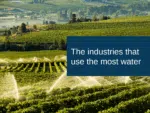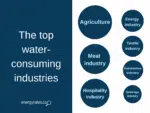The biggest water consumers by industry

Water is becoming an increasingly important topic for large companies, not only because of their high consumption (and high water bills), but also because of the environmental impact of their operations. If you’re curious to understand why some industries consume so much water, and what they can do to reduce water costs, and their water footprint, read our guide below.
Large industries, such as factories or power plants, are frequently pointed out as the biggest water consumers. In Canada, manufacturers located in Ontario withdrew 1,862 million m3 in 2021 — a volume that represented 8.4% of the total water withdrawal of the province, among businesses.
However, if we were to rank the top water-consuming business sectors, many would be surprised to know it’s the agricultural niche.
To give you a clearer view, according to the World Bank website, in most regions of the world, over 70% of freshwater is used for irrigation to grow food in general (the amount of water required for agricultural production varies depending on the climate, soil type, and irrigation method)… But it’s not only about planting, harvesting, or anything related to agriculture and its types (conventional, vertical farming, organic farming, and others). Animals need water too, and cows, for example, drink gallons of water every day.

| Industry Type | Water Consumption (we highlight these numbers will depend on the business size and specific features) |
| Agriculture | 118,000 million gallons per day (source) |
| Meat Industry | 150 to 450 gallons per animal (source) |
| Hospitality Industry | 100-400 gallons (source) |
| Energy Industry | 1,857 gallons of water was used per megawatt-hour of electricity produced. (source) |
| Textile Industry | 10 gallons of water per pound of production (source) |
| Automotive Industry | 39,000 gallons per car (source) |
| Beverage Industry | 20 – 500 gallons (source) |
How to save on agricultural water costs
- Rainwater harvesting and soil moisture management.
- Using drought-resistant crop varieties.
- Investing in technology to optimize water use and reduce waste.
- Water-efficient technologies.
- Automated monitoring systems.
Canadian companies that can help agricultural businesses reduce water bills
Below, we are going to talk about other businesses that are part of the water consumption ranking, including tips on how to save and why some businesses use more water than others. Although we won’t talk about water audits in all of them to avoid repetition, it’s essential to highlight in this paragraph that, to save and discover gaps, equipment needs, and maintenance, and get expertise tips on how the company could improve on water consumption, water audits would be the first step.
Energy Industry
For the energy industry, as water is essential for cooling processes in gas, nuclear, and some renewable energy facilities, water consumption is high. Moreover, the energy industry requires a substantial volume of water for internal processes and production activities involved in energy generation, especially when we talk about hydroelectric power, tidal energy, small-scale hydro, and more.
According to CloudGlobal, coal and nuclear plants withdraw the most, over 20% of total US freshwater. So, the percentage shows that power plants that use cooling towers, common in nuclear and fossil fuel power generation, can consume vast amounts of water. The oil and gas industry also requires a significant quantity of water for hydraulic fracturing (up to 9 million gallons per well).
How to Save on Water Costs in the Energy Industry
- Using dry cooling technologies for thermal power generation.
- Developing Water-free fracking techniques to reduce water consumption.
- Recycling and reuse of wastewater in energy production.
- Water-efficient technologies.
- Automated monitoring systems.
Canadian services that can help energy companies reduce water bills
Automotive Manufacturing
The automotive industry is one of the major consumers of water, considering processes can use over 39,000 gallons of water during surface treatment and coating, paint spray booths, washing, rinsing, hosing, cooling, air-conditioning systems, and boilers.
But with increasing environmental concerns and the sustainability culture of companies, automotive manufacturers are adopting water management practices to reduce consumption, improve environmental practices, enhance reuse, and improve overall efficiency. According to Dupont, it is possible to make top-performing auto manufacturers while setting water efficiency goals as low as 1 m3 per unit by identifying water use inefficiencies and systematically addressing them.
How to Save on Water Costs in the Automotive Industry
- Installing flow restrictions on the tap water supply line.
- Drying and sweeping all areas before hosting,
- Eliminating leaks.
- Installing rainwater tanks.
Canadian services that can help the automotive industry reduce water bills
Hospitality Industry
When we talk about water consumption statistics and conservation for this sector, which includes hotels, restaurants, we may not think the niche is another major consumer of water. However, it is important to highlight that, according to studies, the daily average water usage per hotel room ranges from 100-400 gallons used from running kitchens, washing dishes, washrooms, to maintaining swimming pools and operating laundry services.
Although one could think that most of the wasted water in hotels comes from pool maintenance and other shared spaces, this actually comes from simple things such as showers and toilets, as people are not so worried about utility costs or water savings when not at home.
However, climate change boosts the business concern regarding waste. That’s why water-saving actions, such as water-efficient appliances (for example, WaterSense-labelled products), are becoming increasingly popular.
How to Save on Water Costs in Hospitality
- Reusing Water.
- Installing Water-Saving Showerheads.
- Installing Tap Aerators.
- Installing smart water meters.
- Using water-efficient laundry equipment.
Canadian companies that can help the hospitality sector reduce water bills
Meat Industry
It is estimated that the meat industry uses from 500 to 800 billion cubic meters of water per year, accounting for approximately 8% of the global water consumption. This water-intensive industry requires large amounts of the natural resource to feed production and animal hydration.
What also explains these numbers is that water is also used during the meat process, including cleaning, sanitizing equipment and facilities.
How to Save on Water Costs in the Meat Industry
- Water recycling and treatment technologies.
- Reducing food waste.
- Improving supply chain efficiencies.
Canadian companies that can help the meat industry reduce water bills
Beverage Industry
Soft drinks, juices, and alcoholic beverages… There is a significant consumption of water in the beverage industry in reason of being in most cases the main ingredient, used also for cleaning or sanitizing processes, cooling, and even packaging production (manufacture of plastic, cans, bottles).
However, the Beverage Industry Environmental Roundtable report, on the Benchmarking Study Trends & Observations published in 2024, says from 2017 to 2022, water use, energy consumption, and emissions intensity decreased by 8%,11%, and 22% respectively.
Therefore, as it is possible to see above, in all industry niches, there are efforts (from behaviour to equipment changes) to reduce water consumption through water reuse, recycling, in many other possibilities to improve budget and efficiency.
How to Save on Water Costs in the Beverage Industry
- Wastewater is treated and reused for non-potable purposes.
- Water-efficient technologies.
- Automated monitoring systems.
Canadian companies that can help the meat industry reduce water bills
Textile Industry
On average, 90–95% of the water used by factories ends up as effluent due to the needs of each internal process.
Popular, cotton material is the most widely used natural fibre in clothing production, and demands a significant amount of water for its preparation, while synthetic fibres, wool, and silk require lower water volumes per unit of product.
Another process in the fashion industry that has a large impact on water use is textile dyeing, which can use half a trillion gallons of freshwater annually and consequently lead to high water bills, especially if there is inappropriate use.
How to Save on Water Costs in the Textile Industry
- Using more waterless dyeing techniques.
- Checking leaks.
- Water-efficient technologies.
- Automated monitoring systems.
Canadian companies that can help the textile industry reduce water bills
Reviewing commercial utility options and costs
Looking to reduce your operational costs? EnergyRates.ca can help you review and reduce your utility costs beyond water usage. Our experienced team of energy consultants can support you in comparing electricity and natural gas plans for your commercial, large commercial or industrial operations.
In addition to lower bills, EnergyRates.ca can also help businesses with corporate sustainability solutions, including Carbon Accounting, RECs and Carbon Offsets, and VPPA information.
Contact us or call us at 1-855-635-9608 for a custom quote based on your energy needs.











